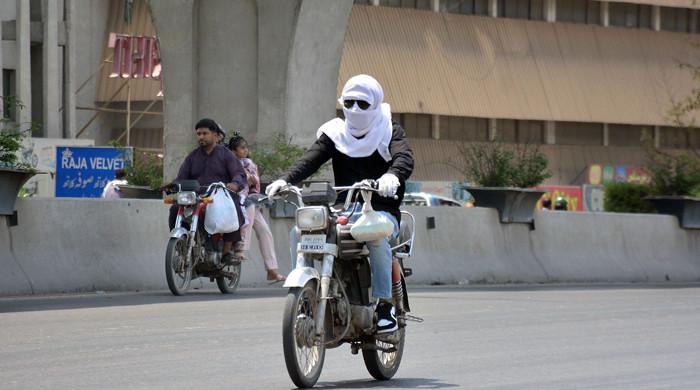Important Advisory: Heatstroke Safety Tips For Bikers
In Pakistan’s ongoing heatwave, the average temperature during 9 to 5 stays between 40- 44° Celcius. Bike riding in this temperature can feel like torture, with scorching air slapping against your body and the engine adding its own heat, as if you’re being pricked by pins on your ankles.
We know not everyone can afford an AC car, and no one can stop going to work just because it’s too hot out there. Therefore, here are some tips you can take from us to reduce the intensity of heat a bit during this ongoing heatwave and protect your body from the risk of heat stroke.
Important Advisory: Riding a bike in this heatwave poses a serious threat of the heatstroke. If riding is necessary for you, you must follow all the possible precautions to reduce the chances of heatstroke, some are mentioned in this blog.
Cover Your Forehead with a Wet Cloth
Use a towel, napkin, or any piece of cotton cloth that can absorb water in high quantities. Now place that wet cloth on your forehead and wear a helmet over it.
When air passes through the wet cloth covering your head, it cools the hot air by some degrees, usually around 7°C. This helps to keep your head cool, preventing brain from overheating and protecting you from heatstroke.
There’s a simple science behind it. When you put a wet cloth on your head, hot air passing through it causes water molecules to absorb heat and evaporate, hence cooling your head.
Drink More and More Chilled Water
Before leaving the house, try to drink as much chilled water as you can. That water will work as a coolant in your body and stop it from overheating. If chilled water is not accessible, just drink normal water; you must stay hydrated.
The body uses water to produce sweat, which cools down the temperature. In dehydration mode, the body can’t produce sweat, thus disrupting the natural cooling mechanism and causing the body to overheat.
If your work is related to bike riding, e.g., food delivery, ride-hailing, deliveries, or lengthy tours, then make sure to keep drinking water after every 45 minutes.
Try Not to Ride a Bike From 11 am – 4 pm in the Morning
Unless absolutely necessary, avoid riding a bike between 11 am and 4 pm and stay indoors if possible. This timeframe sees the peak intensity of sunlight, which increases the risk of heatstroke.
If you have outings, vacations, or shopping plans, it’s better to postpone them to evening or night. Don’t risk yourself for unnecessary activities.
If it’s your job or important work, then you must follow the precautions mentioned in this article to lower the risk of heat stroke.
Tune Your Bike on Time
Your bike’s engine oil will run out faster in the hot season than in the cold season. Engine oil is designed to lose its lubricating ability at a specific temperature and start to deteriorate during hot season.
Our motorcycle engines are air-cooled, and they cool down with the help of air. But, with the outside temperature reaching above 40°C, it’s like cooling down the engine with a hairdryer.
Overheating of the engine during this season is common. Therefore, it’s recommended to replace the engine oil earlier than normal. For example, if the oil manufacturer recommends changing oil after 1,000 Km, we recommend changing it after 800 Km if your daily running is high, especially in the daytime.
Don’t Park in Direct Sunlight
If you do, make sure you have a bottle of water and a napkin to clean.
You park the bike, visit the store, and come back after an hour; we’re sure that the seat will be as hot as a BBQ on the grill. So if you have no choice but to park your bike in the sun, keep a water bottle with you so that you can pour water on the seat to cool it down and a handkerchief to wipe off excess water.
Wear a Helmet, Gloves, and Full-sleeve Shirts
The main objective is to protect your body from sunlight as much as possible. A helmet is a good way to cover your head from direct sunlight, and it’s not only for safety purposes but also because of sunlight. Also, wear bike gloves to prevent tanning and try to wear full-sleeve shirts so you don’t get hot air slaps on your arms.
“But full-sleeve shirts will make the body feel hotter than a half-sleeve” now that will appear in your mind. Trust me, even if you’re riding a bike at 40 km/h wearing a half-sleeve shirt, the hot air hitting your arms will feel so intense. Wearing a full-sleeve shirt would be a much better choice in that situation.
Other things you can follow to reduce the risks of heatstroke:
- Wear light colored clothes
- Avoid eating food with high protein content
- Keep washing your hands with water to maintain blood flow in the nerves
- Wear shoes that can pass the air through your feet; avoid wearing leather shoes.
Signs of Heatstroke
- Dry skin that doesn’t sweat
- Problems with movement and coordination
- Feeling confused
- Dizziness
- Hands and arms turn yellow
- Gurgling noise from lungs like as if you have a cough
- Rapid breathing
- Weakness
- Blurry vision
If you experience any of these symptoms while riding, stop the bike immediately, drink cold water or juice, pour as much water as you can on yourself, put a wet cloth on your head, and call 1122 immediately.
Remember, heatstroke is a severe, life-threatening condition that can cause permanent nerve or brain damage if immediate assistance is not provided.


